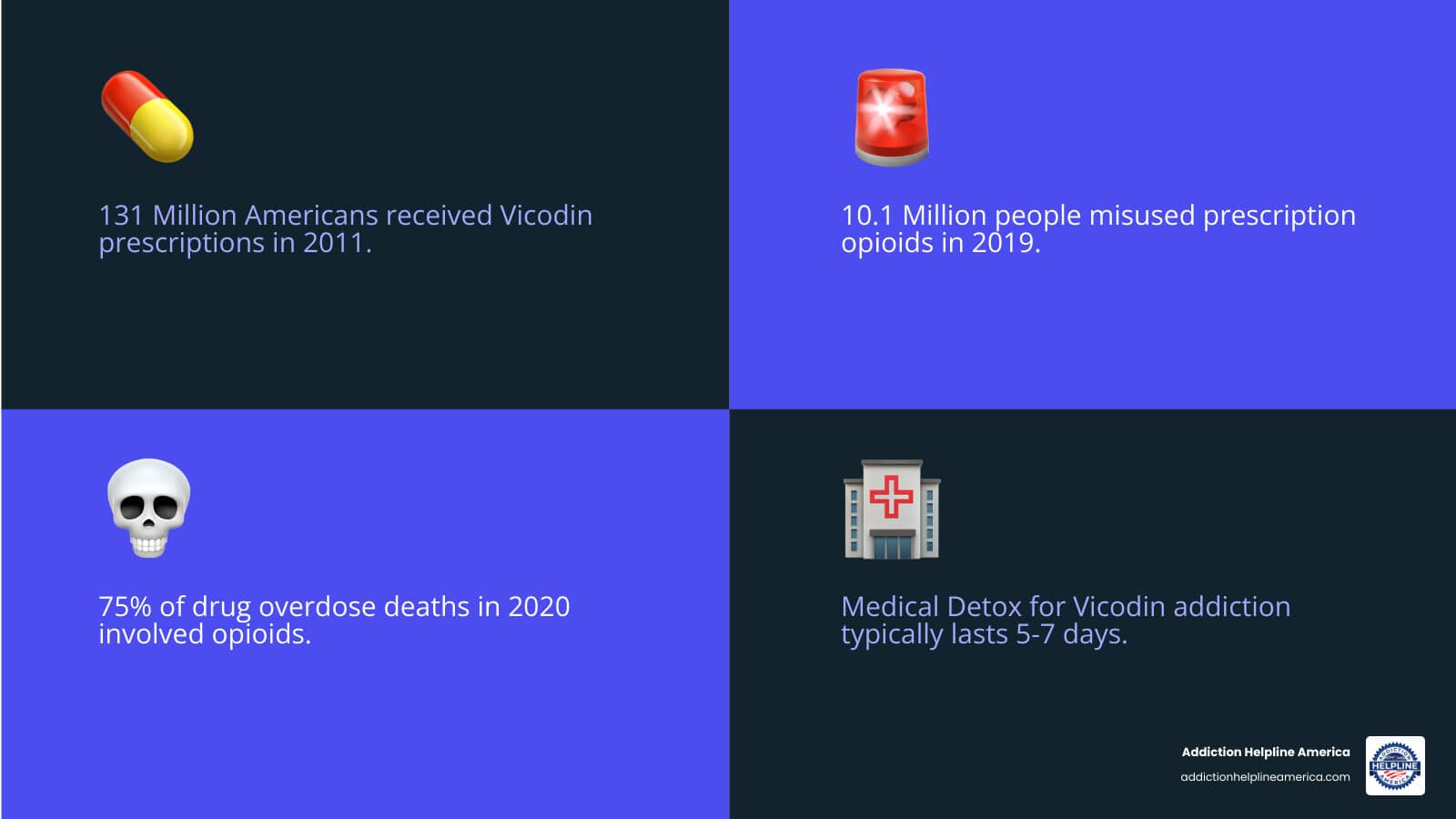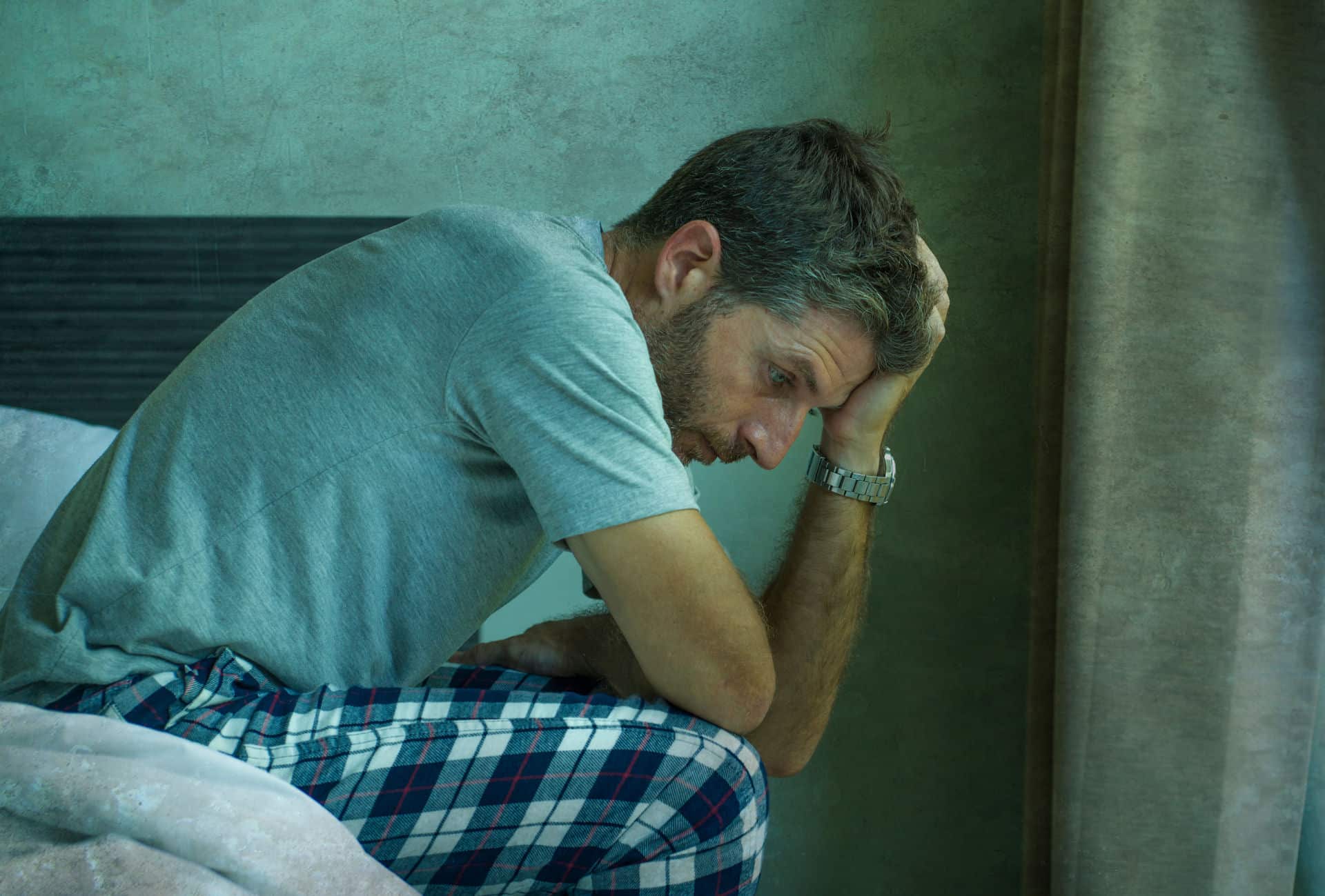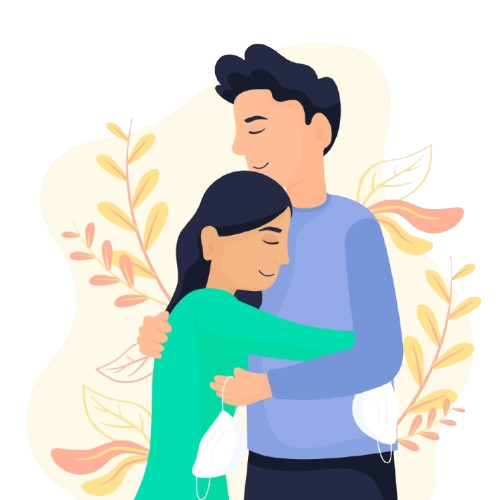Your Journey to a Healthier Life Starts Here
Free Insurance Verification
Verify Your Treatment Coverage
Verify Your Treatment Coverage
Vicodin Treatment includes several key options for recovery:
Vicodin is a prescription painkiller combining hydrocodone (an opioid) and acetaminophen. While effective for pain, its hydrocodone component activates the same brain receptors as heroin, creating a high potential for addiction.
The scale of the issue is staggering. In 2011, up to 131 million Americans received Vicodin prescriptions, contributing to an opioid crisis declared a public health emergency by 2017. In 2019, 10.1 million people misused prescription opioids, and opioids were involved in about 75% of drug overdose deaths in 2020.
But there’s hope. Vicodin addiction is treatable, and professional treatment combining medical support and therapy helps thousands find recovery.
At Addiction Helpline America, we connect people with the right resources for recovery. Our specialists offer 24/7 confidential support to guide you through every step of Vicodin Treatment, from assessment to long-term sobriety.

Vicodin, a combination of hydrocodone (a synthetic opioid) and acetaminophen (Tylenol), is prescribed for moderate to severe pain. Its effectiveness, however, comes with serious risks.
Hydrocodone binds to opioid receptors in the brain, blocking pain signals and releasing a flood of dopamine—the brain’s “feel-good” chemical. This creates euphoria and relaxation, leading the brain to crave more and hijacking its natural reward system, as explained in the neuroscience of drug reward and addiction.
The acetaminophen provides additional pain relief but poses a risk of liver damage, especially at high doses or when mixed with alcohol. The FDA now limits acetaminophen in these pills to 325 mg to mitigate this danger.
Long-term Vicodin use can lead to serious health issues, including heart disease, a weakened immune system, and digestive problems. Mental health can also suffer, with users developing depressive disorders or anxiety. This highlights why Vicodin Treatment must be comprehensive and address the whole person. Our guide on the Definition of Addiction offers more insight.
Understanding the distinction between these commonly confused terms is crucial.
Physical dependence is the body’s natural adaptation to a drug. If you stop suddenly, you’ll experience withdrawal symptoms like cramps, sweating, and nausea. Dependence can occur even without addiction.
Opioid tolerance is when you need higher doses to get the same effect because your body has adjusted. Tolerance and dependence often develop together, even with prescribed use.
Addiction is a chronic brain disease characterized by compulsive use despite negative consequences. It involves losing control, drug-seeking behavior, and neglecting responsibilities. The shift from dependence to addiction can be gradual and often goes unnoticed until significant harm has occurred.
| Feature | Physical Dependence | Addiction (Opioid Use Disorder) |
|---|---|---|
| Nature | Body’s adaptation to regular drug use | Chronic brain disease affecting behavior |
| Withdrawal Symptoms | Yes | Yes |
| Control Over Use | Can usually stop with medical help | Loss of control, inability to stop |
| Compulsive Behavior | No | Yes, constant drug-seeking |
| Harmful Consequences | May not cause life problems | Continued use despite serious harm |
| What Drives It | Biological adaptation | Brain changes affecting judgment and cravings |
Common side effects of Vicodin include drowsiness, constipation, nausea, dizziness, and headaches. These can impact daily life, and a good Vicodin Treatment plan will help manage them.
Serious side effects require immediate medical help. The most dangerous is respiratory depression (slowed or stopped breathing), which can be fatal. Other serious risks include severe skin reactions and adrenal gland problems.
Mixing Vicodin with other substances is extremely dangerous. Alcohol and other CNS depressants (like Xanax, Valium, or Ambien) also slow breathing and heart rate, and combining them can lead to a fatal overdose.
Avoid Vicodin if you’ve recently taken an MAO inhibitor due to the risk of life-threatening serotonin syndrome. Combining it with other opioids or certain antidepressants also increases risks. Always inform your doctor of all medications and supplements you take. For more details, consult the FDA’s drug safety resources.
It can be hard to spot when prescribed Vicodin use becomes an addiction. The change is often gradual, but there are clear behavioral, physical, and psychological warning signs.

Behavioral changes are often the first red flags. These include neglecting responsibilities, doctor shopping for more prescriptions, sudden financial issues, and becoming secretive or socially withdrawn. Taking more Vicodin than prescribed or being preoccupied with the drug are also key signs.
Physical signs include neglected hygiene, weight changes, and pinpoint pupils. Chronic drowsiness or “nodding off” is common. When not using, flu-like withdrawal symptoms (sweating, aches, nausea) appear. Chronic constipation is also a frequent issue.
Psychological signs involve unpredictable mood swings, increased anxiety (especially without the drug), and intense cravings. A key feature is denial—refusing to admit there’s a problem and continuing use despite obvious harm to health, relationships, or work.
If these patterns sound familiar, it’s time to consider professional Vicodin Treatment. Our guide on Signs and Symptoms offers more information.
Professionals diagnose Opioid Use Disorder (OUD) using criteria from the Diagnostic and Statistical Manual of Mental Disorders, 5th Edition (DSM-5). This standardized approach helps create an effective Vicodin Treatment plan. You can explore the full Diagnostic and Statistical Manual of Mental Disorders for more detail.
A diagnosis requires at least two of the following criteria occurring within a 12-month period:
The number of criteria met determines the severity: mild (2-3), moderate (4-5), or severe (6+). This classification guides the intensity of the treatment plan, ensuring care matches the disorder’s severity.
Vicodin Treatment works, and recovery is possible. Professional treatment provides a safe, supportive environment to detox, address the root causes of addiction, and learn skills for long-term sobriety. Effective treatment is personalized, based on an assessment of your physical and mental health, addiction severity, and other co-occurring issues.
Treatment exists on a continuum of care. Inpatient rehabilitation offers 24/7 support in a residential facility, ideal for severe addiction. Outpatient programs, like IOPs and PHPs, provide flexibility to live at home while attending therapy. This allows you to move between levels of care as you progress in recovery. Learn more about Outpatient Addiction Treatment Programs.
Medication-Assisted Treatment (MAT) is a powerful tool in Vicodin Treatment. It combines FDA-approved medications with therapy to manage withdrawal, reduce cravings, and stabilize brain chemistry, which significantly improves recovery outcomes. Research shows that Medications for Opioid Use Disorder Save Lives.
These medications are not “trading one addiction for another.” They are medical tools that help the brain heal, reduce relapse and overdose risk, and provide the stability needed to rebuild your life.
While medication stabilizes the brain, behavioral therapies are essential for changing the thoughts and habits that drive addiction.
Many programs also use holistic therapies like yoga, meditation, and art therapy to support overall well-being and provide healthy outlets for stress and emotions. These approaches help heal the whole person. For more on support, see our guide on Help a Drug Addict: Recovery Support.
The most effective Vicodin Treatment programs combine these approaches, custom to your specific needs, to help you build a life you don’t want to escape from.
Understanding Vicodin’s risks includes knowing how to prevent overdose, use it safely, and dispose of it properly. These precautions can save lives.

Take the first step towards a healthier life! Call now to connect with our compassionate team and start your recovery journey today. Your path to healing awaits!
Our recovery specialists are available 24/7 to provide support, and all calls are confidential and free. Reach out anytime – we’re here to help!
An opioid overdose is a life-threatening medical emergency. Key signs include: slowed or stopped breathing, being unconscious or unresponsive, pinpoint pupils, blue or purplish skin/lips, and choking or gurgling sounds.
If you suspect an overdose:
For more, see the CDC’s guide on What to Do if You Think Someone is Overdosing.
To use Vicodin safely, follow your prescription exactly—never take more or share it. Work with your doctor to set pain management goals and explore non-opioid alternatives. Be transparent about all medications you take to avoid dangerous interactions.
For cancer pain, opioids like Vicodin can be essential for quality of life, used under close medical supervision. During pregnancy, regular opioid use can cause Neonatal Opioid Withdrawal Syndrome (NOWS) in newborns. Abruptly stopping is dangerous. Medically supervised Vicodin Treatment with buprenorphine or methadone is safer for both mother and baby than untreated addiction.
Properly store and dispose of Vicodin to prevent misuse. Keep it in a locked cabinet. Use drug take-back programs for disposal. If unavailable, follow FDA guidelines. For tips, see the Safe disposal recommendations. If you miss a dose, skip it and resume your normal schedule. Never take a double dose.
Here are clear, honest answers to common questions about Vicodin Treatment.
Treatment length varies. Detox is typically 5-7 days. Inpatient rehab can last 30-90 days, while outpatient programs offer flexible timelines over several months. Recovery is a lifelong process, and aftercare—like support groups and ongoing therapy—is crucial for long-term success. Explore Outpatient Addiction Treatment Programs for flexible options.
Yes, most insurance plans cover Vicodin Treatment. The Affordable Care Act mandates addiction treatment as an essential health benefit. Coverage for private insurance, PPO, HMO, Medicaid, or Medicare varies. Always verify your benefits with your insurance provider or let the treatment center’s admissions team help. They can clarify costs and pre-authorization needs. For more, see our guides on Insurance Covers Rehab and Rehab Centers That Accept Medicaid.
Taking the first step toward Vicodin Treatment is the most courageous one. Here’s how to start:
This guide has shown that while Vicodin carries serious addiction and health risks, Vicodin Treatment is effective. Recovery is achievable through a combination of medical detox, medication-assisted treatment (MAT), and behavioral therapies. Whether inpatient or outpatient, a personalized plan can help you reclaim your life.
Recovery begins with the decision to ask for help. That moment of honesty is the turning point.
At Addiction Helpline America, our mission is to be there for that moment. Our compassionate coordinators are available 24/7 for a free, confidential call. We will listen without judgment and help you find a treatment center that fits your needs and insurance.
A life free from Vicodin is possible. Take the first step today. Reach out to us, and let’s walk the path to recovery together. Explore different types of treatment programs to see what’s right for you.
Are you or a loved one struggling with addiction? Call today to speak to a treatment expert.
Calls to any general helpline will be answered or returned by one of the treatment providers listed, each of which is a paid advertiser:
Our helpline is available 24 hours a day, 7 days a week at no cost to you and with no obligation for you to enter into treatment. We are committed to providing support and guidance whenever you need it.
In some cases, Addiction Helpline America charges our verified partner a modest cost per call. This fee helps us cover the costs of building and maintaining our website, ensuring that we can continue to offer this valuable service to those in need.
Calls to the general helpline will be answered or returned by one of the listed treatment providers, all of whom are paid advertisers.
By using the helpline, you agree to the terms of use. We do not earn any commission or fee based on the treatment provider selected by the caller, and there is no obligation to pursue treatment.
This service is not affiliated with Alcoholics Anonymous World Services, Inc.